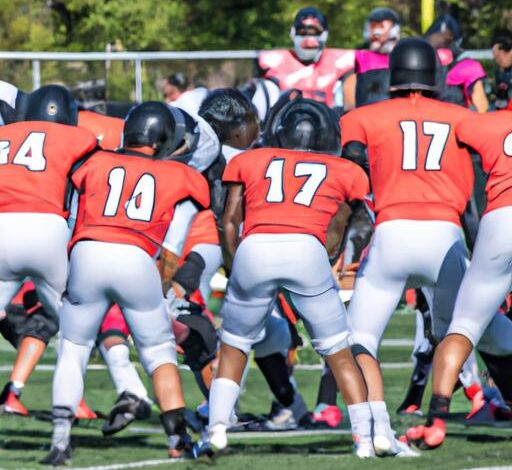What is Zone Defense in Football?

Football is more than just a game of brute force and offensive prowess. It is a tactical battle that requires a solid defensive strategy to counter the opponent’s attacks. One such strategy that has gained immense popularity in football is zone defense. In this article, we will delve into the world of zone defense, unraveling its intricacies and understanding its significance on the field.
Understanding the Importance of Defensive Strategies
Defensive strategies play a pivotal role in football, as they aim to thwart the opponent’s offensive maneuvers and protect the team’s end zone. While there are various defensive tactics employed, zone defense stands out as a well-coordinated approach that focuses on space rather than individual players.
Defining Zone Defense in Football
Zone defense, in simple terms, is a defensive strategy where players are assigned specific areas or zones on the field to defend, rather than marking individual opponents. The primary objective of zone defense is to cover specific areas, anticipate the opponent’s moves, and disrupt their passing lanes. By doing so, it effectively limits the opponent’s options and increases the chances of interceptions or incomplete passes.
Importance of Understanding Zone Defense
For both players and coaches, comprehending the intricacies of zone defense is crucial. As a player, understanding zone defense enables you to effectively read the game, anticipate plays, and position yourself strategically. On the other hand, coaches need to impart the knowledge of zone defense to their players, ensuring a cohesive and well-executed defensive unit. By mastering zone defense, teams can enhance their overall defensive capabilities and outmaneuver their opponents.
Overview of the Article’s Main Headings
Throughout this article, we will explore zone defense in detail, covering various aspects that contribute to its effectiveness. We will decipher the key principles of zone defense, delve into different zone defense strategies and variations, and analyze its application in different game situations. By the end, you will have a comprehensive understanding of zone defense, equipping you with the knowledge to excel on the football field.
Stay tuned as we dive into the world of zone defense, uncovering its secrets and unlocking its potential for success. Whether you are a player seeking to enhance your defensive skills or a coach aiming to fortify your team’s defense, zone defense is an essential aspect of the game that demands attention and understanding. Let’s embark on this journey together and unravel the mysteries of zone defense in football.
Understanding Zone Defense
Exploring the Concept of Zone Defense
Zone defense is a defensive strategy employed in football that focuses on dividing the field into specific zones, with each player responsible for defending their assigned area. Unlike man-to-man defense, where players mark individual opponents, zone defense prioritizes the protection of space. By strategically positioning players across the field, teams can effectively cover passing lanes and limit the opponent’s options.
Differentiating Zone Defense from Man-to-Man Defense
While man-to-man defense involves players directly marking individual opponents, zone defense takes a more collective approach. In zone defense, players are responsible for a designated area, allowing them to anticipate plays and react accordingly. This approach not only adds an element of surprise but also facilitates teamwork, as players can communicate and support each other in defending specific zones.
Employing Zone Defense on the Football Field
To implement zone defense, teams typically utilize various formations such as Cover 2, Cover 3, or Cover 4. These formations determine the number of defenders assigned to each zone and dictate their positioning on the field. Each player must understand their role within the zone defense scheme and be aware of potential threats within their assigned area. This requires constant communication and coordination among teammates to ensure effective coverage.
Advantages and Disadvantages of Zone Defense
Zone defense offers several advantages that make it a popular choice for teams. It allows players to defend areas rather than individual opponents, making it harder for the offense to exploit matchups. Zone defense also provides better coverage against deep passes and allows defenders to read the quarterback’s eyes, increasing the likelihood of interceptions. However, zone defense does have some drawbacks, such as potential vulnerabilities in coverage gaps and difficulties in defending against quick, short passes.
Understanding the intricacies of zone defense is crucial for both players and coaches. By comprehending the concept of zone defense, differentiating it from man-to-man defense, understanding its implementation on the field, and considering its advantages and disadvantages, you can develop a solid foundation for mastering this defensive strategy. So, let’s continue our exploration of zone defense and uncover more insights in the following sections.
Key Principles of Zone Defense
When it comes to executing a successful zone defense, several key principles come into play. Understanding these principles is essential for players and coaches alike, as they lay the foundation for a well-coordinated and effective defensive strategy.
Formation and Positioning of Players in Zone Defense
The formation and positioning of players in zone defense are crucial for its success. Each player is assigned a specific zone to defend, and their positioning within that zone is vital. By strategically placing players in areas that cover passing lanes and potential threats, the defense can effectively limit the opponent’s options and create opportunities for interceptions or disruptions.
Primary Responsibilities of Each Player in a Zone Defense
In zone defense, each player has specific responsibilities within their assigned zone. These responsibilities may include tracking receivers, defending specific areas, or providing support to teammates. By understanding their roles and executing their responsibilities diligently, players can collectively create a formidable defensive unit capable of neutralizing the opponent’s offense.
Communication and Coordination Among Players
Communication and coordination are vital aspects of zone defense. Players must communicate with each other to ensure seamless coverage and quick adaptations to the opponent’s movements. Effective communication allows players to alert teammates of potential threats, passing routes, or adjustments required based on the offensive formation. This level of coordination enhances the overall effectiveness of the defense and minimizes coverage gaps.
Adjustments and Adaptations During Gameplay
While zone defense provides a solid framework, the ability to adapt and make adjustments during gameplay is crucial. As the opponent’s offense evolves and introduces new strategies, the defense must be able to respond accordingly. This may involve shifting zones, altering positioning, or making changes based on the offensive patterns observed. The flexibility to adapt ensures that the defense remains unpredictable and capable of countering the opponent’s tactics effectively.
By adhering to these key principles, zone defense becomes a formidable strategy that can stifle even the most potent offenses. The formation and positioning of players, their assigned responsibilities, effective communication, and the ability to adapt are all foundational elements that contribute to the success of zone defense. Mastering these principles will elevate the defensive capabilities of players and teams, providing a solid foundation for victory on the football field.
Zone Defense Strategies and Variations
Zone defense in football offers a range of strategies and variations that teams can employ to confound their opponents. Let’s explore some of the key elements that make zone defense formations effective and the tactics used to maximize their impact.
Different Types of Zone Defense Formations
Zone defense formations come in various shapes and sizes, each with its own unique characteristics and responsibilities. Some of the most common zone defense formations include Cover 2, Cover 3, and Cover 4.
Cover 2
Cover 2 is a popular zone defense formation where two deep safeties split the field in half. The cornerbacks are responsible for defending the short zones along the sidelines, while the safeties cover the deep zones, preventing long passes.
Cover 3
Cover 3, as the name suggests, involves three deep defenders, each responsible for a third of the deep zone. The cornerbacks cover the outside thirds, while the free safety patrols the middle third, providing support against deep passes.
Cover 4
Cover 4, commonly known as “quarters,” features four deep defenders, with each responsible for a quarter of the deep zone. This formation aims to prevent long passes by effectively covering all areas of the field.
Strengths and Weaknesses of Each Zone Defense Formation
Each zone defense formation has its own set of strengths and weaknesses. Understanding these can help coaches devise effective game plans and players execute their roles efficiently.
While Cover 2 provides solid coverage against short passes and runs, it can leave the middle of the field vulnerable. On the other hand, Cover 3 offers excellent deep coverage but can be susceptible to intermediate routes. Cover 4, with its four deep defenders, provides comprehensive coverage against deep passes but can leave the underneath zones open.
Common Tactics and Techniques Used in Zone Defense
To effectively execute zone defense, players must employ various tactics and techniques. These include “reading the quarterback,” where defenders focus on the quarterback’s eyes and movements to anticipate throws, and “pass-offs,” where defenders communicate and hand off receivers as they enter their respective zones.
Additionally, zone defense often involves disguising coverage, where defenders initially line up in one formation but shift into another just before the snap, confusing the offense and disrupting their timing.
Examples of Successful Implementation of Zone Defense in Football History
Zone defense has been a cornerstone of successful defensive strategies throughout football history. One notable example is the “Tampa 2” defense, famously employed by the Tampa Bay Buccaneers during their Super Bowl-winning season in 2002. This aggressive variant of Cover 2 combines zone coverage with linebacker blitzes, creating chaos for opposing offenses.
By studying successful implementations of zone defense in the past, players and coaches can gain valuable insights and inspiration for their own defensive strategies.
In the next section, we will explore how zone defense performs in different game situations, offering further insights into its versatility and adaptability on the football field.
Zone Defense in Different Situations
Zone defense is a versatile strategy that can be adapted to various game situations, allowing teams to effectively counter different offensive tactics. Let’s explore how zone defense functions in specific scenarios and the adjustments required to maximize its effectiveness.
Zone Defense in Stopping the Run Game
When facing a strong running team, zone defense can be a valuable tool in containing their ground attack. By assigning defenders to specific zones, the defense can clog running lanes and limit the opponent’s ability to gain significant yardage. Linebackers play a crucial role in reading the play, filling gaps, and making tackles. Maintaining gap integrity and ensuring proper communication among defenders are vital to successfully stopping the run game.
Zone Defense in Defending Against the Passing Game
Zone defense is particularly effective in thwarting the passing game. By having defenders cover specific areas, they can disrupt passing routes and create opportunities for interceptions or deflections. Safeties and cornerbacks play key roles in zone coverage, reading the quarterback’s eyes, and reacting accordingly. Communication and coordination among defenders are crucial to avoid coverage breakdowns and exploit the weaknesses in the opponent’s passing game.
Zone Defense in Specific Game Situations
Zone defense becomes even more critical in specific game situations, such as the red zone or the two-minute drill. In the red zone, where the opponent is close to scoring, zone defense can prevent touchdowns by congesting the area and limiting passing options. The two-minute drill requires a quick and efficient defensive response, and zone defense aids in preventing big plays and forcing the opponent to settle for shorter gains.
Adjustments Needed for Zone Defense Against Different Opponents
To effectively utilize zone defense against different opponents, adjustments are necessary. Each team has unique offensive schemes and player strengths, requiring the defense to adapt accordingly. This may involve changing zone coverages, altering positioning of defenders, or focusing on specific players. Analyzing the opponent’s tendencies and making timely adjustments are vital to neutralize their offensive threats.
By understanding the nuances of zone defense in various game situations, teams can maximize its potential and create a formidable defensive unit. Whether it’s stopping the run, defending against the pass, or adapting to specific game scenarios, zone defense provides a strategic advantage that can disrupt the opponent’s game plan. Stay tuned as we continue our exploration of zone defense and unlock its secrets for success.
Conclusion
In conclusion, zone defense in football is a strategic approach that emphasizes collective spatial coverage rather than individual marking. Its importance cannot be overstated, as it serves as a powerful tool in thwarting the opponent’s offensive efforts and protecting the team’s end zone.
Throughout this article, we have explored the fundamentals of zone defense, understanding its definition and significance in the game of football. We have delved into the key principles of zone defense, highlighting the formation, positioning, and responsibilities of players within this strategy. Additionally, we have examined various zone defense formations, tactics, and adaptations, showcasing the versatility and adaptability of this defensive approach.
Zone defense plays a pivotal role in different game situations, whether it be stopping the run game, defending against the passing game, or making crucial adjustments in high-pressure scenarios like the red zone or the two-minute drill. By mastering zone defense, teams can effectively neutralize their opponents and gain a competitive advantage on the field.
As players and coaches, it is imperative to continually study and refine our understanding of zone defense. By doing so, we can harness its potential and elevate our defensive capabilities. Zone defense requires coordination, communication, and a deep understanding of the game. It demands players to read the field, anticipate plays, and work cohesively as a unit.
In the realm of football, zone defense is a game-changer. It is a strategic masterpiece that allows teams to control the flow of the game and outwit their adversaries. So, embrace the power of zone defense, hone your skills, and become an unstoppable force on the field.
Remember, football is a game of strategy, and zone defense is the key to unlocking success. So, go forth, conquer the field, and let the power of zone defense guide you to victory!
Conclusion: So above is the What is Zone Defense in Football? article. Hopefully with this article you can help you in life, always follow and read our good articles on the website: investment.camerahuzz.com



